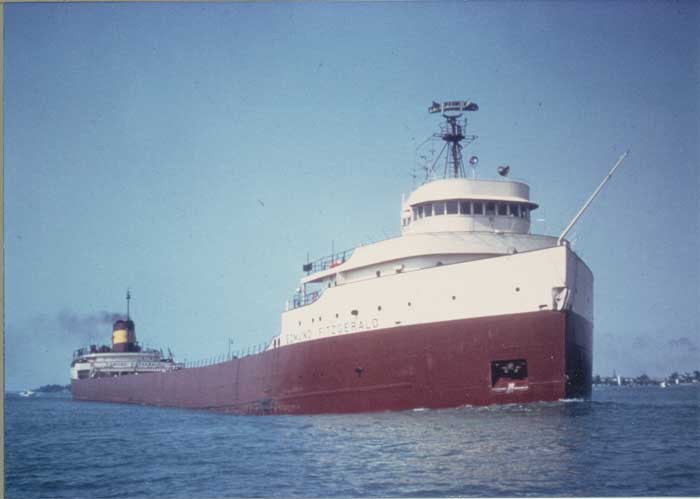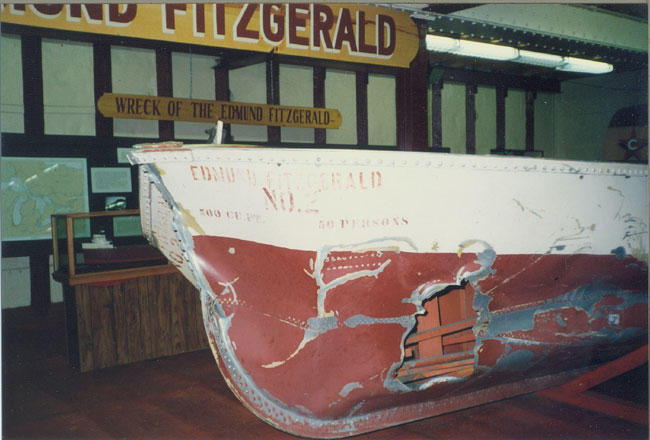Shipwreck: Edmund Fitzgerald

This fall marks the 35th anniversary of the loss of the Great Lakes ore carrier Edmund Fitzgerald. The ship disappeared in a November gale on Lake Superior. All 29 sailors on board were lost.
The ship’s demise has been well documented in books, articles, films and song. What is not conclusively known it the reason why the ship went down. Recent evidence seems to lead to the conclusion that it was overwhelmed by a rogue wave.
The Edmund Fitzgerald was a product of the Great Lakes Engineering Works, River Rouge, MI. It was launched on June 7, 1958, and entered service several months later, on September 22, departing for Silver Bay, MN to load iron ore for Toledo, OH.
At 729 feet, 3 inches in overall length by 75 feet at the beam, this was the largest ship on the Great Lakes at that time. Power was supplied by a Westinghouse steam turbine engine that generated 7,500 shaft horsepower with steam from a pair of coal-fi red water tube boilers.
The 13,632 gross ton carrier set several cargo records. It loaded 22,475 gross tons out of Silver Bay on June 18, 1960, to set a new standard that was surpassed on numerous occasions. It was the fi rst laker to top 26,000 tons, the first over 27, 000 tons and, in 1968, the first to carry 30,000 tons. In 1968 the Edmund Fitzgerald moved 1,358,074 tons of cargo through the Soo Locks setting a new single season record. The ship is shown on July 4, 1968, in a photo by Rev. Peter J. Van der Linden.
The Edmund Fitzgerald was operated as part of the Columbia Transportation Co. fleet but was actually owned, as an investment, by the Northwestern Mutual Life Insurance Company.
On May 1, 1970, the Edmund Fitzgerald was in a collision with the Canadian steamer Hochelaga at the mouth of the Detroit River. Both vessels were downbound with cargo when the accident occurred and the Edmund Fitzgerald lost an anchor in the confrontation.
During the winter of 1971-1972, the boilers were fully automated and converted to burn oil rather than coal.
After loading the final cargo of ore at Superior, WI, Edmund Fitzgerald headed across Lake Superior on November 10, 1975. Due to the gale warnings, the Captain took a more sheltered course following the north shore and was almost to the quieter waters of Whitefi sh Bay when the ship went down. It simply disappeared from the radar screen of nearby vessels without any explanation. All on board were lost in the sudden sinking and no bodies were ever found.
The hull was subsequently located by a robot camera and was found broken apart. The stern rests upside down in 530 feet of water while the heavily damaged bow section is nearby and upright on the bottom.
Some investigators theorized that the ship may have struck bottom passing over a shoal area and was holed. Others suspect water leaked through the hatch covers. A recent investigation however, suggests that the ship was overwhelmed by a rogue wave and could not recover.
Two life boats broke free and are on display at the Valley Camp Museum at Sault Ste. Marie, MI. The damage, shown in a photo by Norm Wood on September 9, 1991, was believed to have been infl icted by the thrashing propeller striking the lifeboat as the freighter sank.
Had the Edmund Fitzgerald survived the now famous November Gale, it is diffi cult to determine its future. The fleet that operated it no longer exist as a Great Lakes shipping company but, if the vessel had been converted to a selfunloader, as a number of fl eetmates had, it may be still plying the occasionally tumultuous waters of the Great Lakes for another owner.


